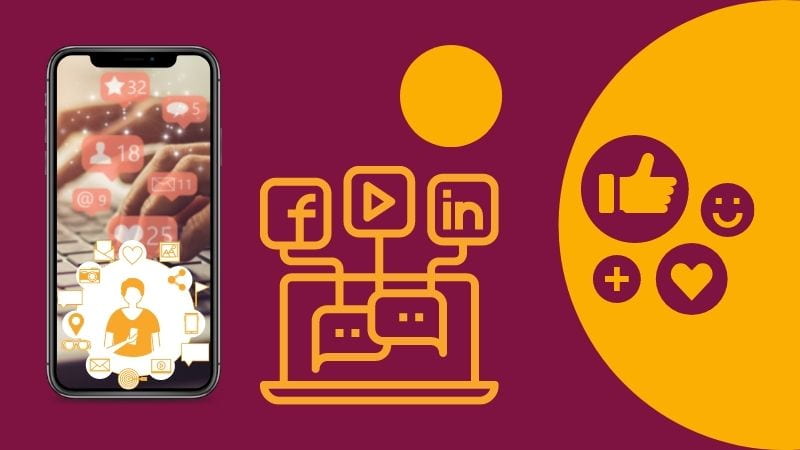It is a widely accepted belief that social media is a distraction. This belief is no exception for Emerick, Caldarella, and Black (2019), who state that “social media can distract students’ attention from their coursework” (p. 269). Another way it is distracting is when students are near others using social media. They will be distracted by the constant buzzing or pinging sounds or the screen’s flashing when something interesting happens on social media. For example, while a student was typing a project in the library, a phone dinged frequently enough that continuing to work was difficult. Thus, one must accept and address the challenges that social media brings to education because social media will continue to exist.
Social Media in Education
This is a series of blog posts on social media. Read more about…
Challenges
Cyberbullying is a concern difficult to observe live. According to Hadjipanayis et al. (2019), cyberbullying exists due to the anonymity that the internet provides[4. Hadjipanayis, A., Efstathiou, E., Altorjai, P., Stiris, T., Valiulis, A., Koletzko, B., & Fonseca, H. (2019). Social media and children: What is the paediatrician’s role? European Journal of Pediatrics, 178(10), 1605–1612.Belangee, S., Bluvshtein, M., & Haugen, D. (2015). Cybersocial connectedness: A survey of perceived benefits and disadvantages of social media use. Journal of Individual Psychology, 71(2), 122–134.]. Cyberbullying is similar to bullying or intimidating someone thought of as weaker, except it is done virtually through social media. In other cases, it is not the anonymity that allows for cyberbullying; it is how the internet provides a distance that prevents immediate physical retaliation. Thus, the bully impacts the victims negatively without facing the consequences. However, that is not the only way to affect people psychologically. As mentioned by Belangee, Bluvshtein, and Haugen (2015), for some, loneliness can be intensified, while social media can desensitize others to violence[5. Belangee, S., Bluvshtein, M., & Haugen, D. (2015). Cybersocial connectedness: A survey of perceived benefits and disadvantages of social media use. Journal of Individual Psychology, 71(2), 122–134.].
One problem with social media is not social media itself. The digital divide refers to the lack of access to digital resources while others have complete access. Although at one point the digital divide may have referred to how low-income families did not have access to computers, that has changed. Recently, the focus on the lack of access to digital resources changed to internet access. During the COVID-19 Pandemic Shutdown, schools had to continue teaching students. For example, La Joya ISD provided a hotspot, or wireless internet service via a cellular network, to each school family who needed it. However, students went without internet access. The problem was not with the hotspots. However, it was with the lack of cellular signal to reach the hotspots. The infrastructure where some students reside lacks access to the internet or cellular antennas.
Another type of digital divide, according to Bosse, Renner, and Wilkens (2020), occurs to students with complex communication needs and other persons with disabilities[7. Bosse, I., Renner, G., & Wilkens, L. (2020). Social media and internet use patterns by adolescents with complex communication needs. Language, Speech & Hearing Services in Schools, 51(4), 1024–1036.]. There are few or no accessibility settings or options for disabled people to use something with accommodations in some cases. In either case, they would prefer not to “spend their Internet time on social networking or other social uses” (p. 1026) due to the lack of accommodations. The digital divide also removes access to social media through laws preventing minors from accessing some websites. For example, COPPA, or Children’s Online Privacy Protection Act/Rule, where young students under 13 from accessing some websites. Some local regulations may prevent educators from interacting with students on social media. Hadjipanayis et al. (2019) state that laws like COPPA prevent children under 13 from accessing some websites, and as a result, “falsifying age has unfortunately become a common practice for preadolescents” (p. 1607). From that statement, one can conclude that social media poses the challenge of children breaking laws. To continue with the digital divide occurring to underage students is the federal crime of sexting. Sexting is sending sexualized messages over a virtual platform which may include photos or videos. It becomes a crime when a minor takes a nude “selfie” or takes pictures of themselves because even if it is of themselves, that is a nude photo of a minor. Others can quickly propagate those photos through social media via smartphones, which leads to a negative digital footprint.
A digital footprint is messages, images, videos, or other digital media related to an individual, which itself is not harmful but can be damaging to the reputation of anyone. For example, when an employer wants to see if a candidate can take a position in the public eye, that employer may search for the name and use facial recognition software to see what that software will find online. Facial recognition is a type of software that determines if a person is in an image or video. In this example of one teacher, after explaining digital footprints, a student asked about hers. A quick search showed an arrest record. If found, that arrest record can be shared and easily propagated through social media, making her digital footprint more negative. Some may attempt to achieve more “likes” and “shares” or interactions with their social media posts, causing their digital footprint to grow negatively. According to Hadjipanayis et al. (2019), some may portray a picture-perfect life to acquire more views and gain popularity, which may evolve to actions that society would typically criticize and even reject in real life. For example, some may perform stunts that could end tragically or perform illegal actions to get more views and interactions.



[…] Challenges […]
[…] Challenges […]
[…] Challenges (9/10/2021) […]